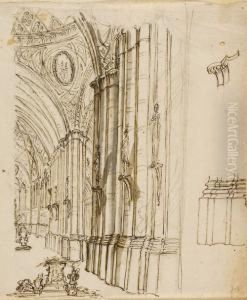Luigi Vanvitelli Paintings
Luigi Vanvitelli was an Italian architect and engineer who is best known for designing the Palace of Caserta, one of the largest palaces ever built in Europe and a UNESCO World Heritage Site. Born in Naples on May 12, 1700, as Luigi Vanditelli, he was the son of the Dutch painter Gaspar van Wittel, who was known in Italy as Vanvitelli. Luigi changed his surname to Vanvitelli to Italianize it.
Vanvitelli trained in Rome, where he was influenced by the works of his contemporaries in the Baroque architectural movement. His early works were primarily in Rome, where he gained a reputation for his skillful renovation of older buildings and the design of new structures. Throughout his career, Vanvitelli was involved in numerous projects, including the restoration of the Basilica di San Paolo fuori le Mura after a fire in 1823 and the design of the Villa Albani in Rome.
His most famous project, the Palace of Caserta, was commissioned by the Bourbon king Charles VII of Naples, who later became Charles III of Spain. The palace, intended to rival Versailles, was constructed between 1752 and 1773 and is considered Vanvitelli's masterpiece. It showcased his ability to blend the grandeur of Baroque architecture with the emerging neoclassical style. Vanvitelli's design included a vast complex of gardens, fountains, and an aqueduct that brought water to the palace from the mountains 25 miles away.
Vanvitelli's influence extended beyond the Palace of Caserta. He was responsible for the design of the Teatro San Carlo in Naples, one of the oldest continuously active opera houses in the world. He also designed the Royal Palace of Naples and contributed to the construction of the Royal Palace of Milan.
Luigi Vanvitelli died on March 1, 1773, in Caserta. His legacy lives on in the grand structures he created, which continue to be celebrated for their architectural beauty and historical significance. Vanvitelli's work marks a transition from the ornate Baroque style to the more restrained neoclassical style that would dominate European architecture in the late 18th century.












